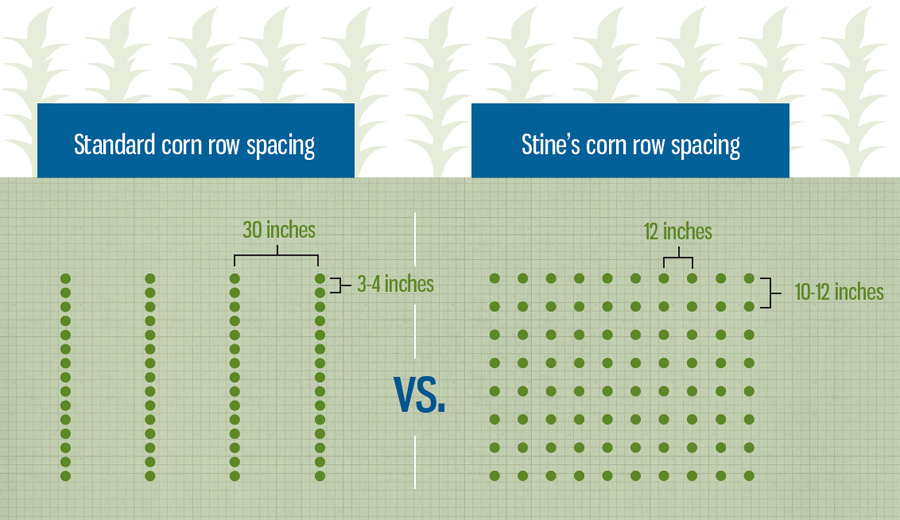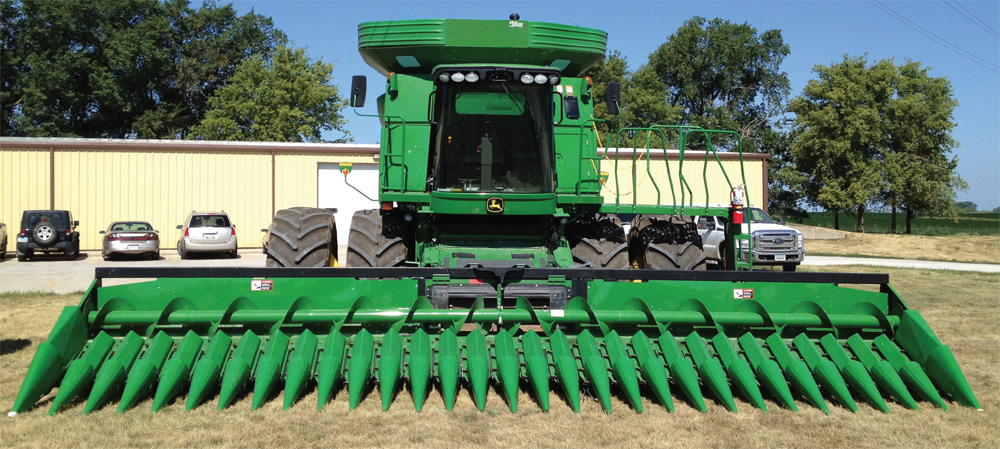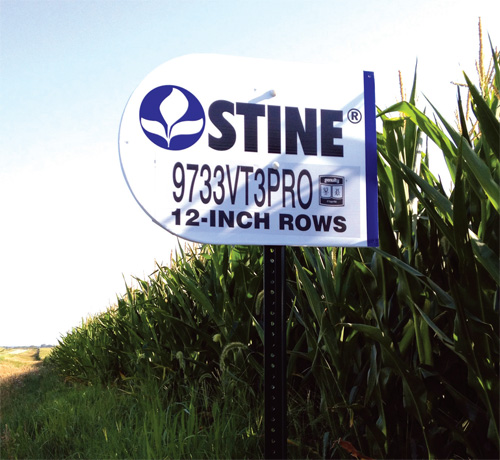Drive past Harry Stine’s 2,500 acres of corn near Adel, Iowa, peer through the summer waves of heat and what you’ll see is a veritable ocean of green.
OK, most all of Iowa shimmers green come summer.
But what differentiates Stine’s fields from his neighbors is the amount of corn plants packed into a single acre – up to 50,000 plants per each 43,560 square feet of rich Iowa soil.
The current national average is 32,000 corn plants per acre. And consider this: When hybrid seed was first introduced in the 1930s, farmers typically planted just 8,000 plants per acre.
A growing demand
According to the Corn Farmers Coalition, farmers today grow five times as much corn as they did in the 1930s – on 20 percent less land. That’s 13 million acres or 20,000 square miles, twice the size of Massachusetts. The yield-per-acre has skyrocketed from 24 bushels in 1931 to 154 now, or a six-fold gain.
The national average of 153 bushels produced on each acre in 2010 was nearly 20 percent larger than the average yield in 2002 – and plant breeding experts estimate yields may jump 40 percent before 2020.
And in a world that’s growing in population – and in demand for grains – the need to squeeze more corn yield out of the same acre of ground is paramount, industry leaders say.
Stine – as well as researchers from Monsanto, DuPont and Syngenta, to name a few – are at the forefront of a movement to push corn yields to 300 bushels per acre – and beyond.
And America’s farmers, well, they are listening. Intently.
Because the next leap in corn yields will help the American farmer nourish a hungry world – and fuel the growing thirst for clean, renewable biofuels right here at home.
“The more corn we have, typically the better off we are in the world, in terms of social stability and in terms of the ability to produce ethanol and distillers grains for the feed markets,” said Fran Swain, POET’s Strategic Development Manager.
Meeting the need
Can the American farmer reach the 300-bushel mark, sooner rather than later?
“I think yes, very much so,” said Roger Elmore, Professor and Extension Corn Agronomist at Iowa State University in Ames. “There are farmers who are doing it now. Eventually, getting the national average to 300 bushels per acre will take a lot of work. Everyone is going to have to do their part, everyone has to work together – the scientist out there, the breeders at the different companies, we need to be all working together.”
The world’s hunger for grains like corn is expected to double by 2050, according to an Iowa State University review.
Combine that with the expectations of the Renewable Fuels Standard, the nation’s clean energy policy, which by 2022 calls for 36 billion gallons of renewable fuel to be used in the U.S. per year.
So many in the farming and ethanol industry say corn yields must continue to increase to meet the ever-growing demand. And that’s where out-of-the-box thinking comes in, that next big leap forward – a 300-bushel-anacre average.
A new way of thinking
Stine’s research not only includes a narrow row and more corn plants per acre, but the corn plant itself. Stine’s corn plants are a little smaller, the tassels too. The leaves point up a little, to grab the sun. In the family test fields of Dallas County, Iowa, Stine employs 12-inch corn rows, with each plant spaced 10 to 12 inches apart. That’s opposed to the standard 30-inch row widths, with plants spaced 3 to 4 inches apart.
“This is a constant, continuing, changing thing,” said Stine, who said he plans to expand his research into denser corn populations in 2013. “If you know, most farmers are planting in the low 30s (30,000 plants per acre). Well, we have some hybrids that can handle the low 40s, some up around 50,000. We expect then to develop those at 60 and 70 and so forth.
“So as we slowly develop the genetics to handle it, the population will go up, and the yield will go up accordingly,” Stine said.
A winning combination
With good genetics, plant population growth, precision agronomics and a wave of new equipment to foster the changes, the American farmer is poised to hit the 300-bushel-per-acre threshold (Stine insists farmers can blow right past it, toward 400 bushels per acre).
The time is coming, many in the farming industry say, when all farmers will be planting newer hybrids in narrower rows, with increased plant populations per acre to get those higher yields.
A combine with a narrow row corn head.
Swain pointed to a Rabobank research paper released in January that seems to confirm the future of farming – that sustaining plant population growth is the key to unlocking corn yield. According to Rabobank, a global leader in food and agriculture lending, some 80 percent of yield growth in U.S. corn harvests depends on increasing plant population density, rather than generating more corn per plant.
“If you look at the Rabobank report, the key to higher yields is to increase the density,” Swain said. “Really, it’s just an issue of the hybrids now.”
And that’s where seed company research comes in.
Bringing it all together
At Monsanto, there’s a threeprong approach to doubling yields, based on breeding, biotech and agronomic practices, said Monsanto spokeswoman Danielle Stuart.
And the company has made the commitment to double its yields by 2030.
“It’s that combination of having the base genetics, having the right systems as you farm to optimize it and really using the information that’s developed, whether it’s developed in the seed, as we think about how we’re developing plants and plant technology, or whether we’re developing it on the field,” said Beth Calabotta, Monsanto’s Bioenergy and Renewables Strategy Lead. “It’s all about integration.”
“I think you also need to keep this in perspective of where we’ve been,” said Mark Lawson, Monsanto’s Yield & Stress Platform Lead. “In the 1970s, when I was growing up on a farm in western Illinois, we averaged about 75 bushels per acre, which was the national average at the time. Now, the national average is about 150 bushels, so we’ve already doubled yield once over the past 30 years.”
“There certainly is historical precedence to do this – but the opportunity here is to take the intersection of a number of technologies at the same time, as compared to more single technologies as we’ve done in the past.”
Beyond hybrid seed that can withstand field crowding, farm equipment manufacturers will need to retool their offerings to meet the demands of higher plant population density, Swain and Stine said.
“The next leap in technology to get to the narrow rows, which in turn will allow for those higher densities, is the equipment side of things,” Swain said.
But Stine cautioned farmers not to dive head-first into increased plant populations on their corn acres. More testing needs to be done to find that next hybrid seed that can withstand crowding season after season – and equipment manufacturers need to catch up with new planters and corn head rows to accept a narrower row.
Photo submitted by Stine Seeds
“We’re not suggesting that anyone go out today and change equipment,” Stine said. “What we’re suggesting is, everyone will be in 12-inch rows eventually, but we don’t have a full range of hybrids that will adapt to high populations at this time – and no one else does, either. So instead of rushing out and buying new equipment, when their equipment needs to be changed, then they might as well switch.”
And moving forward will depend on the American farmer to embrace all the changes that are coming.
“I have full confidence that America’s farmers can deliver all the product needed for the market demand,” Monsanto’s Calabotta said. “If we go back and look at the last decade, we’ve increased our ethanol production from roughly 1 billion gallons around 1993 to some 15 billion gallons in 2012. Our farmers have shown an amazing ability, if there’s market demand, to produce the products that are required. They’ve done it in the past – and they will continue to be able to do it in the future. I have no doubt about that.”










